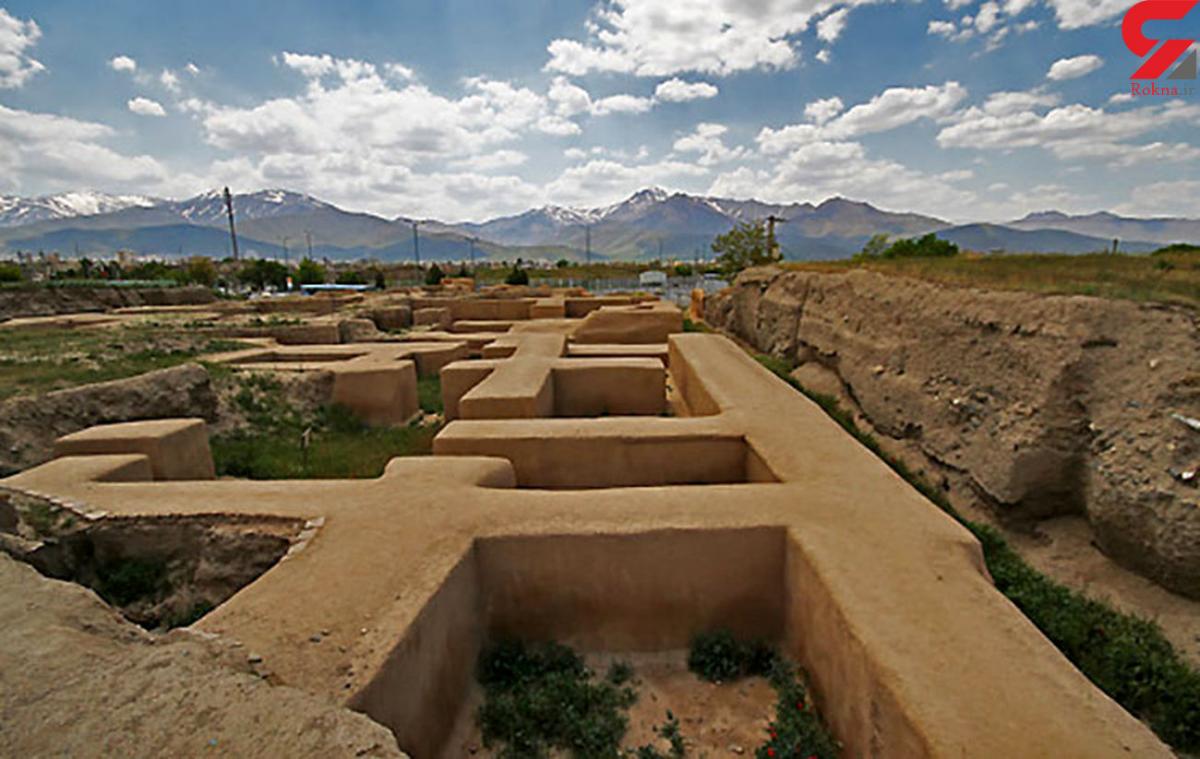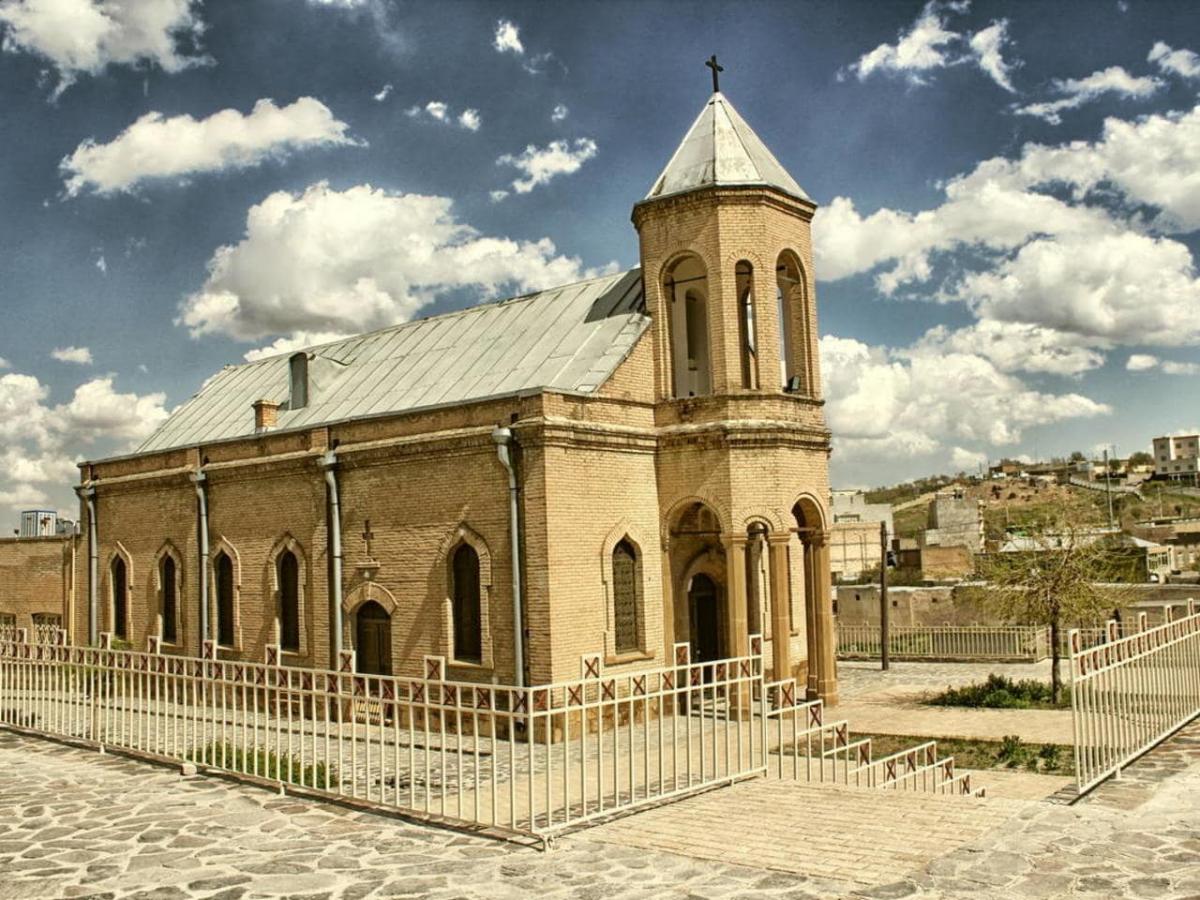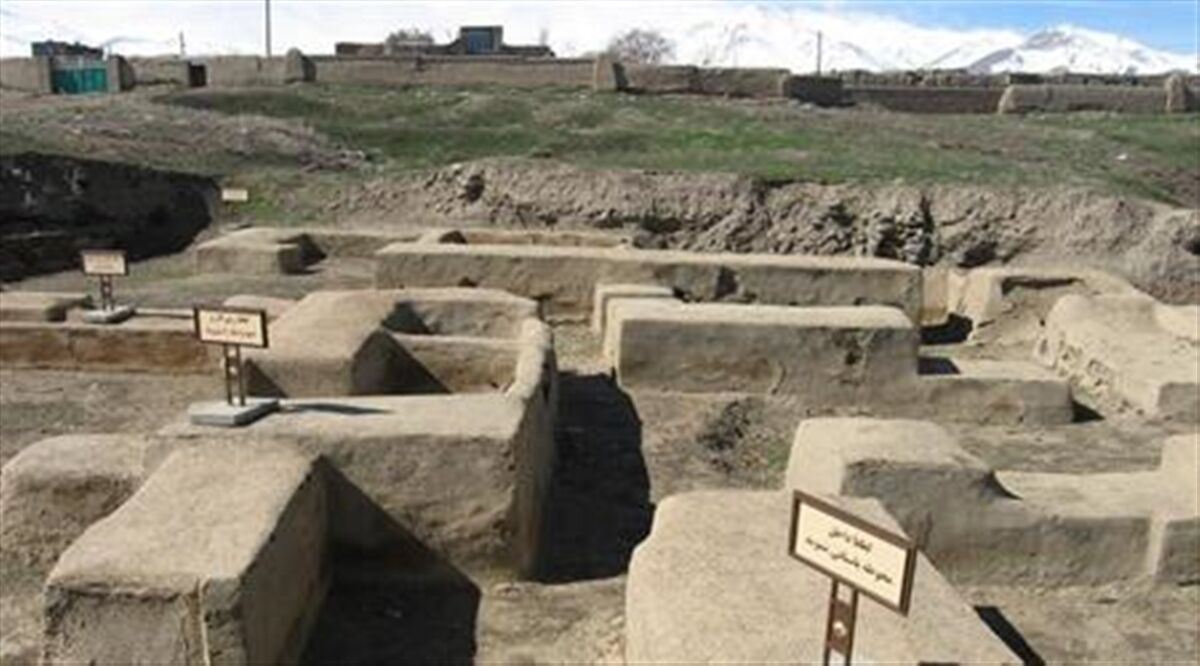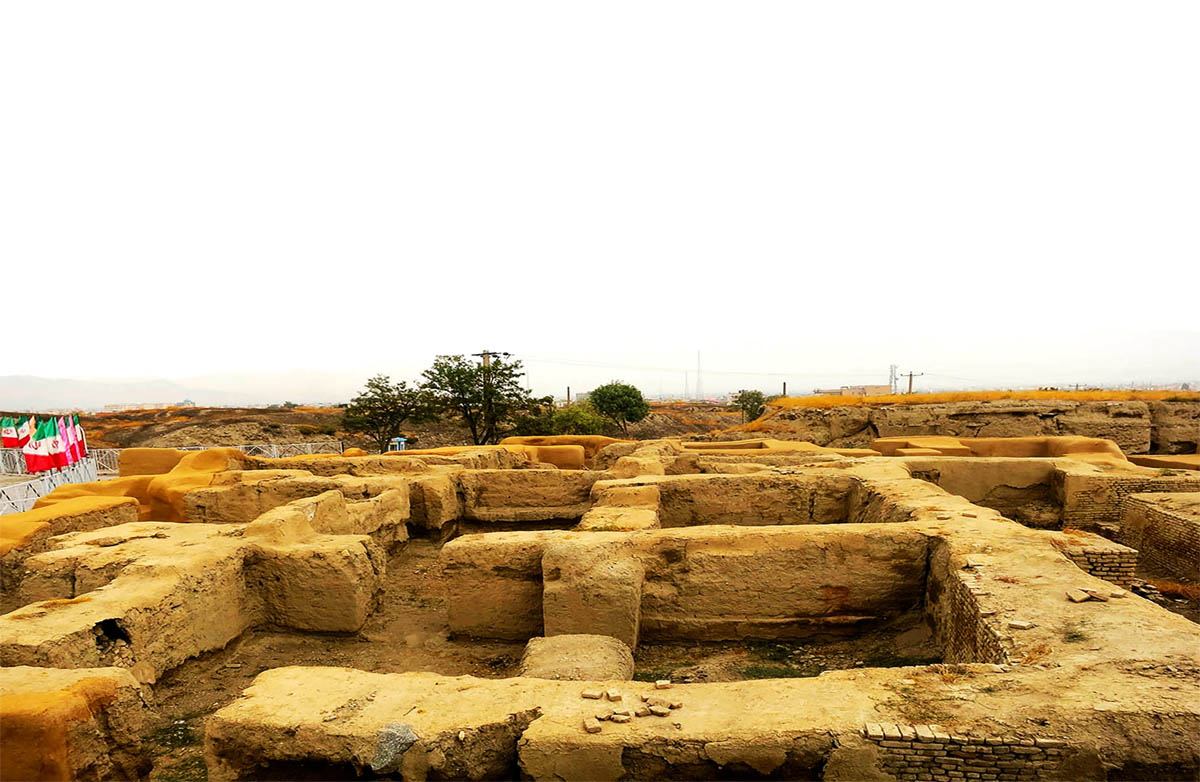Hegmataneh Hill capital of the first kingdom in Iran
Also known as
- Ecbatana
- Hegmatana Hill
- Old Ecbatan
- Amadana
- Hamadan
- The Capital City of Mede
- Hegmataneh City
- Hegmataneh Museum
Geographical location of Hegmataneh Hill
It’s located at the end of Ecbatan Street, on the slopes of Mount Alvand, in the old, northern texture of Hamedan City, Hamedan Province. This ancient hill is 3,000 years old and with an area of about 35 hectares, is the largest ancient hill in Iran. According to some evidence, the hill was more than 40 hectares. But unfortunately, residential buildings have been built on about 5 hectares over time and changed the ancient texture into a modern one.
History and culture of Hegmataneh Hill
Based on indications in historical references and the archaeological evidence, archaeologists and researchers had introduced this site as the “Ancient Hegmataneh”. The underground city in the heart of Hegmataneh Hill reveals its three-thousand-year-old history to the world. The city was found by Aryan people in the late 8th century BC, who made it the first capital of Persian Empire. Based on Herodotus's writings, an ancient Greek historian, Deioces (also Diako or Dia-oku), first shah of Median government, built the whole city surrounded by seven walls; each of which colored as one of the planets. After Medes, this city was the capital of Achaemenids as well.
This hill has been excavated many times by local and foreign archaeologists during the last one hundred years. The history of the scientific excavations of this hill dates back to 1913, when a French delegation from the Louvre Museum in Paris, headed by Charles Fossi, excavated the Hegmataneh Hill. But the results of these excavations were never published.
In the primary excavations, ancient relics such as exquisite ornaments and objects (e.g. a golden cup related to Khashayar Shah, the offspring of Darius), different golden tablets (from the times of Ariamaneh, the father of Arsham), and inscriptions as well as the architectural stone remnants, on which an embossed lion with wings in a leaping position was carved, related to Achaemenian rulers were found which are now on view to the public in the museums of Iran and other countries around the world. The archaeological excavations and findings during 22 seasons today can show a small extent of the glory and mighty of Hegmataneh including the remnants of barrier, tower, and fortifications all around the city and also well designed architectural buildings inside for military or governmental purposes.
In this ancient site beside archaeological and architectural findings, there are two old Armenian churches and a museum each of which displays the history and the culture of this country.
Architecture of Hegmataneh Hill
Hegmataneh Ensemble consists of a unique collection of historical ruins and a valuable archaeological site. A complex collection of congested urban constructions including towers (citadel of the old city) unique urban architecture like a chessboard (Hippodamian) developed system of water pipelines and roads and the pavements as well as a great number of houses rather than single deserted buildings. Utilizing a modern architectural plan, these bricks were made in workshops located in all northern, southern, western, and eastern sides of the city.
The architects of this historical monument designed and built it as seven connected and nested castles. It seems that the people's residential buildings were located in the vicinity of these castles. These interconnected castles were each built for a special use, e.g. the seventh castle or the last inner castle, was built as the king's palace. Historians, of course, attributed the reason for the construction of people's houses next to the Seventh Castle to Deioces's command to relocate the Medes from their residence to the vicinity of the royal palace.
Other Greek historians seem to have used a bit of exaggeration in describing the architecture of this ancient city. They believed one cannot find a part of the king’s palace without ornaments and a wall inside the palace without gold or silver cover. They also assumed that all the wood used was of cypress and praised many of the decorations on the doors, porches, and columns of the buildings.
Excavations carried out in this huge and admirable ancient complex have revealed the remains of a completely advanced and orderly water supply network. The designers have constructed it in such a way that in the distance between the water canals, they have created passageways with a width of up to 3.5 meters. Also, on the floor of these passageways, square bricks have been used as cover.
There were also two series of building units between the passageways. Each quadrangular building has got a porch, a courtyard, warehouses, and rooms on both sides. These buildings were constructed in two parallel rows in the back of each other in such a way that each building unit occupies a space of about 17.5 by 17.5 meters. Between every two rows, paths of 3.5m of width were designed in northeastern and southwestern side of the building.
Tips and ideas
Accordingly, the city walls used to have gold and silver coating that reflected the moon’s light and brightened the city during the night. It is interesting to know that the very first civilization in Iran was formed in this ancient city. My suggestion is to visit this site in the afternoon. Standing on the top of Hegmataneh Hill with the view of distant mountains and watching the sun slowly fades away can help you understand why people, back then, chose this spot to build their very first permanent home.
It may be hard to imagine the city as it once had been, but the nearby museum tries to fill the mental gap. The museum was built in the 1940s with an area of 600 square meters and is located in the eastern part of the hill. Many cultural and historical objects found before and after the Islamic period are on view to the public in the museum.
If you want to get the most out of your day, you can use the map below which shows every nearby monument that can be reached within fifteen minutes. Shal Bafan Mosque, Jameh Mosque, Stephen Gregory Church, and the beautiful traditional bazaar of Hamedan are the places you shouldn’t miss.
IRANWATCHING would love to read your personal experiences. Please share with us in the comments below.
 2020-09-19 14:06:08+3:30
2021-11-09 09:56:42+3:30
This ancient hill is 3,000 years old and with an area of about 35 hectares, is the largest ancient hill in Iran. According to some evidence, the city was more than 40 hectares and was found by Aryan people in the late 8th century BC, who made it the first capital of Persian empire. Based on Herodotus's writings, an ancient Greek historian, Deioces (also Diako or Dia-oku), first shah of Median government, built the whole city surrounded by seven walls; each of which colored as one of the planets. After Medes, this city was the capital of Achaemenids as well.
2020-09-19 14:06:08+3:30
2021-11-09 09:56:42+3:30
This ancient hill is 3,000 years old and with an area of about 35 hectares, is the largest ancient hill in Iran. According to some evidence, the city was more than 40 hectares and was found by Aryan people in the late 8th century BC, who made it the first capital of Persian empire. Based on Herodotus's writings, an ancient Greek historian, Deioces (also Diako or Dia-oku), first shah of Median government, built the whole city surrounded by seven walls; each of which colored as one of the planets. After Medes, this city was the capital of Achaemenids as well.


 eyJpdiI6IkNZOXdKSy9USm5QL3JRYXBVWGVXSFE9PSIsInZhbHVlIjoiNnNHNElyT0czZEFuMGJLSUNlSHZ5QT09IiwibWFjIjoiMWYzY2Q4ZjM1ODYyNWM3YWNmMTIyMzE4YTNhNGY3NGYwZjU2MGUzYTQxYzVmY2ExNjVjMmE1ZDYzODZkZGY4MiIsInRhZyI6IiJ9 eyJpdiI6ImNSSW5pZ0I5VHlJc3A3U09VWFRZTWc9PSIsInZhbHVlIjoiM05NMUZtV0NQenFsOHFNWFRKUTJ0QT09IiwibWFjIjoiZTllZGE4NjhiY2YzNjEzYTI1MmIyY2RkZjEyNzI5NjdiZGQ3YzEzOTY5ZDk2NDZkZWZjNzk4YzI2N2M0MzdkNyIsInRhZyI6IiJ9
Author
info@yaldamedtour.com
/en/user-profile/10233
YaldaMedTour
Barajin Salamat Road
+98
Qazvin
Qazvin, Qazvin Province, Iran.
,
info@yaldamedtour.com
Hegmataneh Hill - capital of the first kingdom in Iran
Hegmataneh Hill - capital of the first kingdom in Iran
eyJpdiI6IkNZOXdKSy9USm5QL3JRYXBVWGVXSFE9PSIsInZhbHVlIjoiNnNHNElyT0czZEFuMGJLSUNlSHZ5QT09IiwibWFjIjoiMWYzY2Q4ZjM1ODYyNWM3YWNmMTIyMzE4YTNhNGY3NGYwZjU2MGUzYTQxYzVmY2ExNjVjMmE1ZDYzODZkZGY4MiIsInRhZyI6IiJ9 eyJpdiI6ImNSSW5pZ0I5VHlJc3A3U09VWFRZTWc9PSIsInZhbHVlIjoiM05NMUZtV0NQenFsOHFNWFRKUTJ0QT09IiwibWFjIjoiZTllZGE4NjhiY2YzNjEzYTI1MmIyY2RkZjEyNzI5NjdiZGQ3YzEzOTY5ZDk2NDZkZWZjNzk4YzI2N2M0MzdkNyIsInRhZyI6IiJ9
Author
info@yaldamedtour.com
/en/user-profile/10233
YaldaMedTour
Barajin Salamat Road
+98
Qazvin
Qazvin, Qazvin Province, Iran.
,
info@yaldamedtour.com
Hegmataneh Hill - capital of the first kingdom in Iran
Hegmataneh Hill - capital of the first kingdom in Iran
 This ancient hill is 3,000 years old and with an area of about 35 hectares, is the largest ancient hill in Iran. According to some evidence, the city was more than 40 hectares and was found by Aryan people in the late 8th century BC, who made it the first capital of Persian empire. Based on Herodotus's writings, an ancient Greek historian, Deioces (also Diako or Dia-oku), first shah of Median government, built the whole city surrounded by seven walls; each of which colored as one of the planets. After Medes, this city was the capital of Achaemenids as well.
This ancient hill is 3,000 years old and with an area of about 35 hectares, is the largest ancient hill in Iran. According to some evidence, the city was more than 40 hectares and was found by Aryan people in the late 8th century BC, who made it the first capital of Persian empire. Based on Herodotus's writings, an ancient Greek historian, Deioces (also Diako or Dia-oku), first shah of Median government, built the whole city surrounded by seven walls; each of which colored as one of the planets. After Medes, this city was the capital of Achaemenids as well.


 Ecbatan Street, Hamedan, Hamedan Province, Iran
+98
Ecbatan Street, Hamedan, Hamedan Province, Iran
Ecbatan Street, Hamedan, Hamedan Province, Iran
IR
Show On Google Maps
Hegmataneh Hill - capital of the first kingdom in Iran
Hegmataneh Hill - capital of the first kingdom in Iran
Ecbatan Street, Hamedan, Hamedan Province, Iran
+98
Ecbatan Street, Hamedan, Hamedan Province, Iran
Ecbatan Street, Hamedan, Hamedan Province, Iran
IR
Show On Google Maps
Hegmataneh Hill - capital of the first kingdom in Iran
Hegmataneh Hill - capital of the first kingdom in Iran
 This ancient hill is 3,000 years old and with an area of about 35 hectares, is the largest ancient hill in Iran. According to some evidence, the city was more than 40 hectares and was found by Aryan people in the late 8th century BC, who made it the first capital of Persian empire. Based on Herodotus's writings, an ancient Greek historian, Deioces (also Diako or Dia-oku), first shah of Median government, built the whole city surrounded by seven walls; each of which colored as one of the planets. After Medes, this city was the capital of Achaemenids as well.
Ecbatan Street, Hamedan, Hamedan Province, Iran
+98
Ecbatan Street, Hamedan, Hamedan Province, Iran
Ecbatan Street, Hamedan, Hamedan Province, Iran
IR
Show On Google Maps
Adults
Persian
English.
This ancient hill is 3,000 years old and with an area of about 35 hectares, is the largest ancient hill in Iran. According to some evidence, the city was more than 40 hectares and was found by Aryan people in the late 8th century BC, who made it the first capital of Persian empire. Based on Herodotus's writings, an ancient Greek historian, Deioces (also Diako or Dia-oku), first shah of Median government, built the whole city surrounded by seven walls; each of which colored as one of the planets. After Medes, this city was the capital of Achaemenids as well.
Ecbatan Street, Hamedan, Hamedan Province, Iran
+98
Ecbatan Street, Hamedan, Hamedan Province, Iran
Ecbatan Street, Hamedan, Hamedan Province, Iran
IR
Show On Google Maps
Adults
Persian
English.
Hegmataneh Hill - capital of the first kingdom in Iran
 This ancient hill is 3,000 years old and with an area of about 35 hectares, is the largest ancient hill in Iran. According to some evidence, the city was more than 40 hectares and was found by Aryan people in the late 8th century BC, who made it the first capital of Persian empire. Based on Herodotus's writings, an ancient Greek historian, Deioces (also Diako or Dia-oku), first shah of Median government, built the whole city surrounded by seven walls; each of which colored as one of the planets. After Medes, this city was the capital of Achaemenids as well.
Ecbatan Street, Hamedan, Hamedan Province, Iran
+98
Ecbatan Street, Hamedan, Hamedan Province, Iran
Ecbatan Street, Hamedan, Hamedan Province, Iran
IR
unknown
This ancient hill is 3,000 years old and with an area of about 35 hectares, is the largest ancient hill in Iran. According to some evidence, the city was more than 40 hectares and was found by Aryan people in the late 8th century BC, who made it the first capital of Persian empire. Based on Herodotus's writings, an ancient Greek historian, Deioces (also Diako or Dia-oku), first shah of Median government, built the whole city surrounded by seven walls; each of which colored as one of the planets. After Medes, this city was the capital of Achaemenids as well.
Ecbatan Street, Hamedan, Hamedan Province, Iran
+98
Ecbatan Street, Hamedan, Hamedan Province, Iran
Ecbatan Street, Hamedan, Hamedan Province, Iran
IR
unknown
Keywords: Hegmataneh Hill,
Nearby Places
Copyright © 2025 To YaldaMedTour. All Rights Reserved.
![]()


